Why Does My Knee Hurt? Potential Causes and Treatment Options
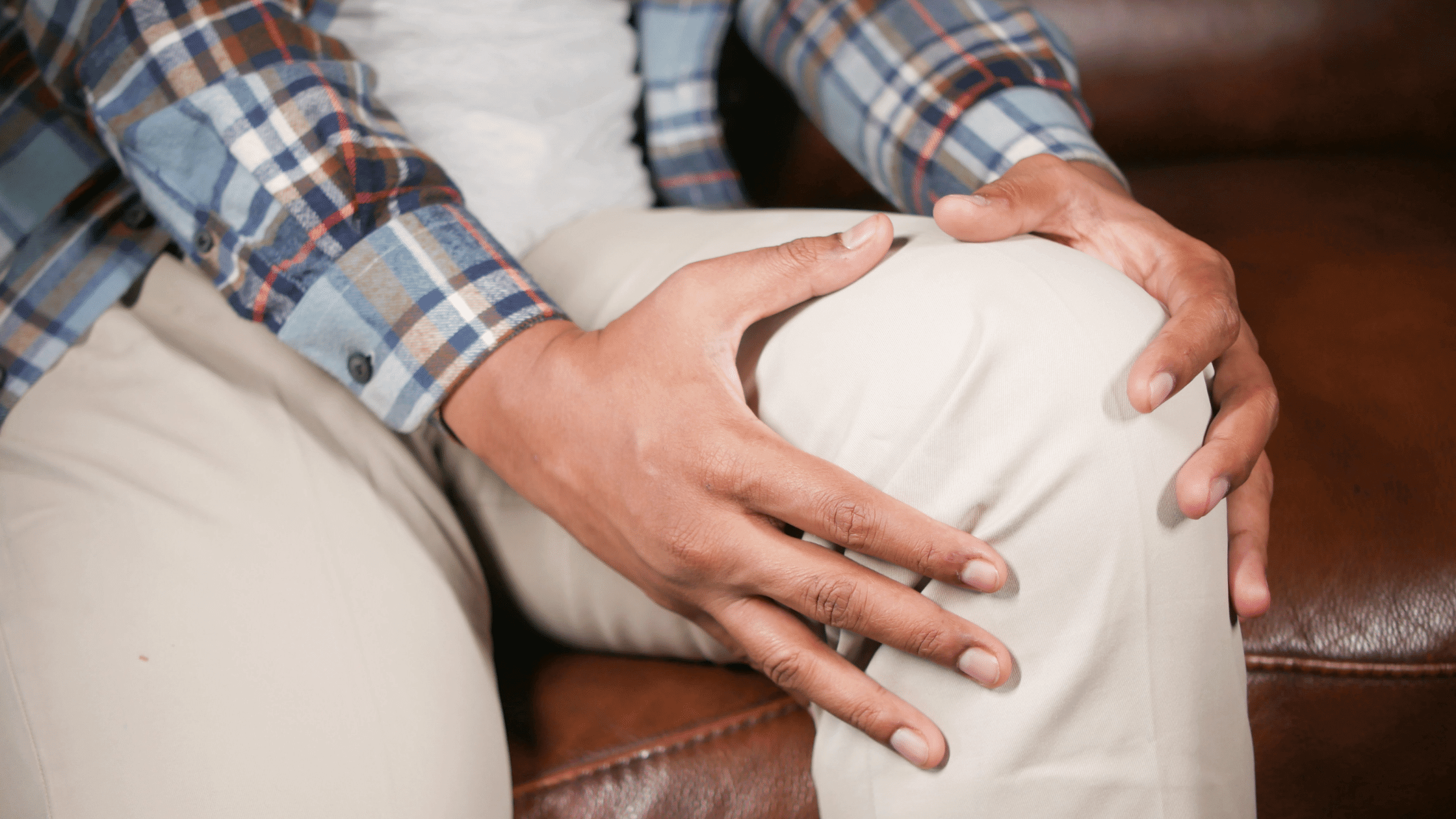
Licensed Physical Therapist, PT , DPT // Clinical Director of EW Motion Therapy Tuscaloosa
Knee pain is common for a large percentage of the population. Any pain in our knees can significantly impact how we move during the day, and there is a myriad of things that could cause pain in your knees, from overuse to ligament tears to arthritis. So when you experience pain, should you be worried? Will you need surgery to fix it, or are other treatment options available?
Short periods of soreness are normal after intense activity, like a long hike. But if your pain is consistently limiting your activities for more than a week, you should go to your doctor for further medical advice, at which point they may refer you to physical therapy. At EW Motion Therapy, we strive to help all our clients move better, so they can ultimately feel and live better. We want to restore the functional movement that you need and give all our patients a personalized experience. Even if we are not involved in your care plan, we still want to ensure you get the help you need for any knee pain you are experiencing.
This article discusses some potential causes of knee pain, specific ways physical therapy can help, and some things you can try at home. With this information, you can leave your pain behind and continue your favorite activities.
What is the knee?
The knee is a complex hinge joint, meaning its primary motion is in one plane of movement. Let’s examine the structure of the joint by breaking it down into its bones, muscles, ligaments, and cartilage structures.
Your knee is the joint that connects your femur (thigh bone) to your tibia/fibula (lower leg bones) and the patella (kneecap). The patella is a floating bone that allows the knee muscles to work more effectively. It acts as a bridge between the two primary tendons in the knee: the quadricep tendon and the patellar tendon. The quadricep is the most important primary muscle group that crosses the knee joint, and it has a significant role in knee extension movement and stability. It is made up of 4 distinct muscles that come together and attach to the patella.
Along with the quadriceps, our knees also have a complex ligament system that creates stability. There are four primary ligaments in the knee joint:
- Anterior cruciate ligament (ACL)
- Posterior cruciate ligament (PCL)
- Medial collateral ligament (MCL)
- Lateral collateral ligament (LCL)
These ligaments connect the femur to the tibia and fibula. Their primary role is to keep the knee in an optimal position by stabilizing the joint against outside forces and preventing it from twisting, sliding, or collapsing.
There are also cartilaginous structures in between the bones to promote smooth motion between joint surfaces. The meniscus is a thick cartilage padding that sits on top of the tibia and redistributes force from the femur to the tibia. You also have articular cartilage between the femur, patella, and tibia that promote smooth motion.
All of these structures come together to make the knee one of the most complex joints in the body and one that is vital for healthy gait patterns. Refer to the diagram below for an overview of the entire joint and all its structures.
![Knee anatomy 2[70]](https://www.ewmotiontherapy.com/hs-fs/hubfs/Knee%20anatomy%202%5B70%5D.jpg?width=5333&height=4000&name=Knee%20anatomy%202%5B70%5D.jpg)
What can cause knee pain?
There are many issues that could arise with your knees, depending on your age, your family history, your hobbies, the sports you play, and your activities during the day. But generally, knee problems can be broken down into two categories: structural problems and functional problems. These issues can cause eachother to happen: a structural problem can create a functional problem, and a functional problem can create or worsen a structural problem. Let’s define what each of these looks like and review some examples.
Structural problems
We’re defining structural problems as any type of injury or dysfunction that can be seen by imaging, like an MRI or X-ray. You could have an injury in your meniscus, typically caused by a forceful twist or rotation at the knee, especially if your full weight is on the knee. You could have developed patella femoral syndrome, where the cartilage behind your kneecap becomes inflamed or damaged due to injury or overuse, or you could have tendonitis, which is also usually caused by overuse or weakness. Another cause to explore would be arthritis in your knee. Or, you could have dislocated your patella. A dislocation occurs when the kneecap does not relocate itself, but if it pops out, then back in on its own, that is subluxation.
Ligament damage is very common in sports where quick lateral movement is needed. There are three grades of injury that define the severity of ligament damage:
- Grade 1: The ligament fibers are overstretched. You can usually still put weight on the knee at this stage, and you may experience minimal pain, swelling, and bruising.
- Grade 2: There is a partial tear. You probably have difficulty putting weight on the knee or bending it, and you will likely have some pain, bruising, and swelling.
- Grade 3: The ligament(s) is/are completely torn. Tears often involve more than one ligament, and this cumulates in not being able to put any weight on the leg/knee or bend it. You will probably have severe pain, swelling, and bruising. Some tears may require surgical repair, depending on the severity of the tear, the structures involved, and the activities to which you want to return.
Functional problems
We classify functional problems as any injury or dysfunction caused by a change in typical movement patterns. These can be related to structural injuries but not always - all joints have a normal aging process where the surfaces may change. Damage may also occur over time if you constantly compensate due to weakness or improper positioning.
Weakness in the quadriceps can reduce stability in the knee itself, but you could also experience instability due to weakness in the glute muscles or your calf muscles. If you have weakness in your hip, it can reduce control of leg positioning during standing activities, which puts stress on the knee. But if the weakness is in your calf, it can cause the quads to work too hard during walking or running, which can cause pain in the knee.
You can also experience knee problems caused by decreased range of motion. This can occur from arthritis, swelling, or a buildup of scar tissue from a previous injury. Tightness can also be a suspect for knee pain, with the hamstring usually being the root of the problem. However, you can also have symptoms of tension from your sciatic nerve, possibly related to sciatica. Additionally, any decreased mobility in your ankle or hip can put added stress on the knee.
Altered gait/walking patterns can put stress on your knee as well due to the change in force distribution. For example, if you have an injury or previous surgery on one knee, and you try to compensate for your movement with the other knee, that can lead to stress from overuse.
How can physical therapy help?
When you see your doctor or physical therapist for your symptoms, they can help you narrow down the exact cause of your pain and find the most effective treatment. If you come to physical therapy for knee pain, your therapist can evaluate your specific deficits with your range of motion, strength, and current activities. The evaluation is key to determining the structures involved - is your pain coming from your knee or somewhere else in the body?
Once they make that determination, your therapist will develop a treatment plan that addresses the root cause. Treatment will vary between individuals, so only your therapist can truly determine what is best for your symptoms. However, many physical therapists use certain principles for recovery, which are:
- RICE method: rest, ice, compression, and elevation. This is typically used when there is inflammation present in the knee.
- Regain range of motion: range of motion in the knee can be changed based on many factors, including pain, swelling, and range of motion before the injury or pain started.
- Increase quadricep activation and strength.
- Improve weight bearing.
- Strengthen the hip and lower leg: if they are performing optimally, you will not have to compensate with your knee.
- Begin dynamic activity: incorporate exercises like squatting, jumping, hopping, and ladder drills.
Our physical therapists have helped many knee pain clients return to their favorite activities. Here are a few examples of some exercises they have assigned. If you want to try any of these at home, check with your doctor to ensure it is safe for you to do so.
Supine Hamstring Stretch: Begin lying on your back with one leg straight and the other leg bent. Bring your knee toward your chest and grab the back of your thigh with both hands. Slowly straighten your knee until you feel a stretch in the back of your thigh and hold. Make sure to keep your back flat on the floor during the stretch.
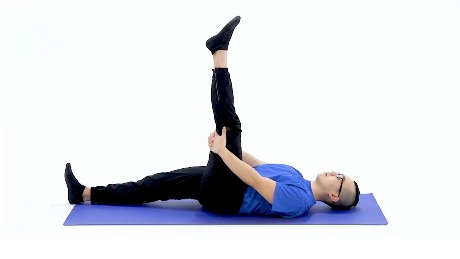
Supine Straight Leg Raises: Begin lying on a bed or flat surface with your affected leg straight and your other leg bent. Pull your toes toward your body, keeping your knee straight, and slowly lift your affected leg off the bed until it is close to parallel with your other thigh. Hold briefly, then lower it to the starting position and repeat. Make sure to keep your thigh muscles tight and your knee straight. Do not turn your foot or hip in or out during the exercise.
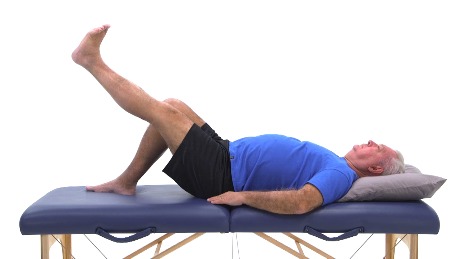
Walking March: Begin in a standing upright position with both elbows bent at 90-degree angles. March slowly forward, lifting one leg to a 90-degree angle, bringing the arm on the same side backward and the opposite arm forward. Make sure to maintain an upright posture and move your arms and legs continuously in unison.
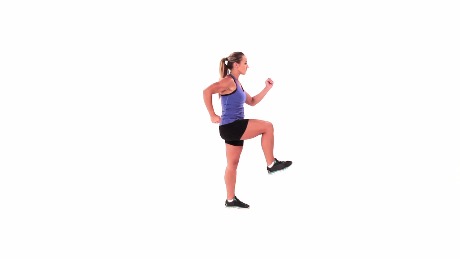
Wall Quarter Squat: Begin standing upright in front of a wall. Lean back into a squat against the wall with your knees bent to 45 degrees, and hold this position. Make sure your knees are not bent forward past your toes, and keep your back flat against the wall during the exercise.
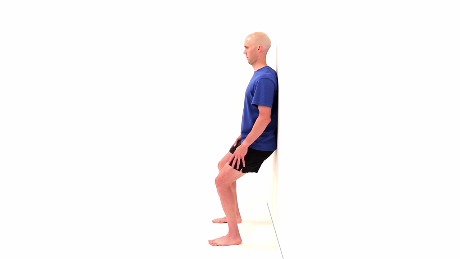
What else can you do at home?
Now you know more about knee pain and some of the possible issues behind it. Other than doing your home exercises regularly, you can lessen your pain by resting and using ice on areas with increased inflammation. Your doctor may also offer you a steroid injection or a more potent painkiller, but if your pain has to do with your range of motion or weakness, they will most likely refer you to physical therapy.
Your knees are important joints for everyday mobility, and pain can easily disrupt your daily routine or favorite activities. It is vital to get the help you need so your pain does not control you. We love helping clients at EW Motion Therapy decrease pain and improve mobility through individualized treatment tailored to their lifestyles and goals. If you are curious about what else physical therapy can do for you, click the button below to download our answers to 20 frequently-asked physical therapy questions.

